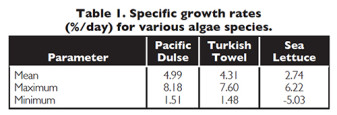Quantity, quality from sustainable food source
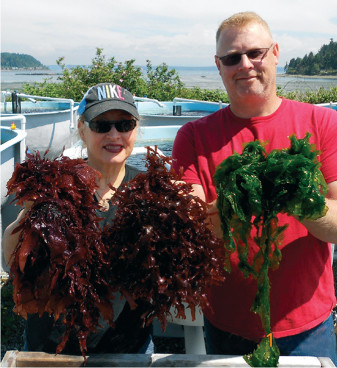
Macroalgae have been used as food in Asia and Europe for centuries. In the United States, the consumption of macroalgae is currently limited and occurs primarily in the states of Hawaii and California. Most of the macroalgae sold in the U.S. is harvested from the wild and sold in Asian markets, high-end restaurants and health food stores.
Macroalgae culture is a productive segment of aquaculture across the world, but there is limited production in the United States. Open-ocean farming of macroalgae in the U.S. is restricted to a few regions, and site permitting is often difficult. However, with increasing need for aquaculture to help sustain food sources in the future, there is great potential for coastal U.S. communities to intensively produce macroalgae in land-based systems.
Key issues that limit the sale of macroalgae in the U.S. include seasonal availability, variable product quality, restrictions on the harvest of wild macroalgae and a lack of commercial distribution channels.
Land-based cultivation systems offer a new approach to minimize impacts on wild macroalgae stocks while reducing harvest costs and better controlling product quality. The integration of macroalgae with land-based fish culture systems can reduce the capital and operating costs of macroalgae production and reduce the discharge of nutrients to the environment.
NMFS research objectives
The U.S. National Marine Fisheries Service has studied the intensive land-based production of macroalgae for human consumption. The project evaluated the potential commercial production of two red and one green macroalgae species by measuring growth rates, nutrient composition and protein quality. This research was conducted at the Manchester Field Station west of Seattle, Washington, USA, a facility that also rears endangered salmon.
Three species of native macroalgae – Turkish towel, Chondracanthus exasperatus; Pacific dulse, Palmaria mollis; and sea lettuce, Ulva rigida – were reared over a 13-month period. The macroalgae were grown in 2,000-L fiberglass tanks operated in airlift circulating culture. The macroalgae were pulse-fertilized twice a week with commercial nitrogen and phosphorus fertilizers and once a week with an f/2 trace metals solution.
The plants were weighed twice a month, and the initial density was adjusted to 10 kg/m3 after each weighing. On a monthly basis, subsamples of each of the three species were dried, ground and analyzed for protein, lipid, ash and amino acids using standard methods.
Growth, production
Over the study, the specific growth rate varied significantly among the species (Table 1). The maximum growth in all species occurred near the summer solstice (Figure 1), and growth rate was directly related to day length or total photosynthetically active radiation. The minimum growth in all species was observed near the winter solstice. Biweekly growth rates of the three species were all positive except for sea lettuce near the winter solstice (Figure 1).
 Annual production rates for a commercial operation producing the three species were estimated from experimental growth rates, initial densities and an assumed 25 percent tank coverage of land area. Annual wet and dry production numbers are presented in Table 2.
Annual production rates for a commercial operation producing the three species were estimated from experimental growth rates, initial densities and an assumed 25 percent tank coverage of land area. Annual wet and dry production numbers are presented in Table 2.
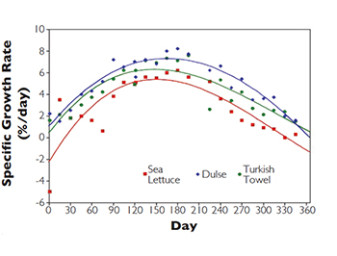
According to U.S. Department of Agriculture data, the average annual dry-weight production of wheat, corn and soybeans is in the U.S. are 3.2, 9.9 and 3.0 mt/ha, respectively. Since most macroalgae are sold wet, macroalgae are many times more productive than conventional agriculture. In addition, these production estimates are based on area tank coverage of 25 percent, a number that will significantly increase for larger commercial farms.
Nutritional composition
While there is abundant proximate composition information on both wild and extensively reared macroalgae in the scientific literature, there is little information available for intensively produced macroalgae in land-based systems. Within a species, no difference in protein, lipid or ash content attributable to season was observed (Figure 2).
All species exhibited high-protein, low-fat profiles with adequate mineral content. Sea lettuce had significantly higher protein and lipid content than the two red macroalgae species. The protein content of the macroalgae was lower than that found in animal proteins, but higher than that of many terrestrial plants.
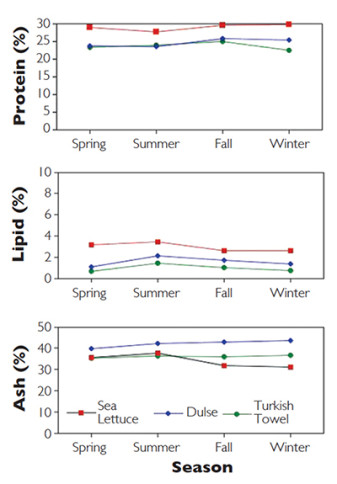 A number of studies have shown that the protein content of wild macroalgae can be highly variable, and the lipid content is generally low. Seasonal variations often occur in protein, with more protein in autumn plants and less in summer plants. Lipid content can also vary, with some green macroalgae having more lipids in autumn months and fewer lipids in summer months. The study data suggested that land-based systems with adequate fertilization can produce year-round red and green macroalgae with consistent nutrient composition.
A number of studies have shown that the protein content of wild macroalgae can be highly variable, and the lipid content is generally low. Seasonal variations often occur in protein, with more protein in autumn plants and less in summer plants. Lipid content can also vary, with some green macroalgae having more lipids in autumn months and fewer lipids in summer months. The study data suggested that land-based systems with adequate fertilization can produce year-round red and green macroalgae with consistent nutrient composition.
Protein quality
The protein quality of the three macroalgae species was high, with essential amino acids accounting for almost half of the total amino acids present. Amino acid profiles for all three species compared favorably with those of conventional foods. Non-essential amino acids related to the “umami” or savory taste in foods such as aspartic and glutamic acids were present in high percentages.
Of the three species studied, Turkish towel had the highest percentage (0.82 ± 0.27 percent) of taurine, a sulfonic acid with human health benefits. Taurine supplied through the diet helps regulate blood pressure and has other benefits to the circulatory system. Taurine is also beneficial to marine fish. The addition of Turkish towel to marine fish feeds may be a useful means to increase the taurine content of the diets, which could prove especially useful when formulating alternative, plant-based feeds.
Perspectives
This study demonstrated the potential for macroalgae aquaculture in the Pacific Northwest of the U.S. and that a land-based macroalgae system can consistently produce large quantities of macroalgae with good nutritional and amino acid profiles. The Puget Sound area offers good water quality and is close to a large urban population. The concentration of large fish-processing facilities in the Seattle area would allow easy access to existing distribution networks for marine food products. Development of a local macroalgae aquaculture industry could improve regional economic health, provide local jobs and supply locally produced healthy foods to the region.
Authors
-
Bradley A. Gadberry
Northwest Fisheries Science Center
National Marine Fisheries Service
National Oceanic and Atmospheric Administration
2725 Montlake Boulevard East
Seattle, WA 98112 USA
[118,111,103,46,97,97,111,110,64,121,114,114,101,98,100,97,103,46,100,97,114,98]
-
John Colt, Ph.D.; Desmond J. Maynard; Ronald B. Johnson
Northwest Fisheries Science Center
-
Diane C. Boratyn
Sol-Sea Ltd.
Seattle, WA, USA
Tagged With
Related Posts
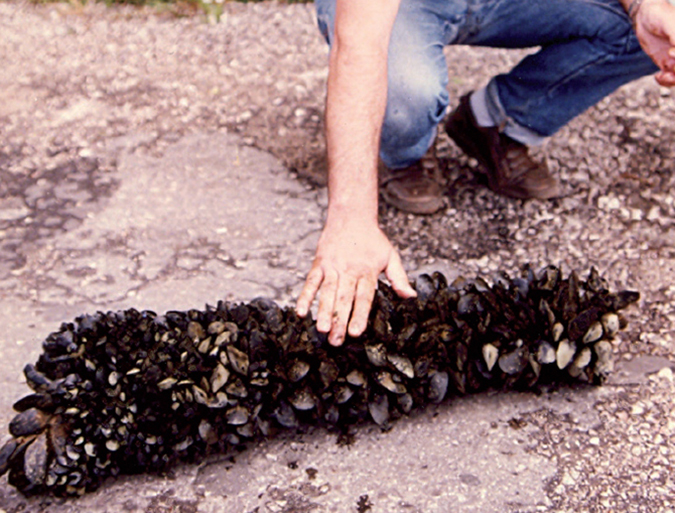
Intelligence
Human enteric viruses in shellfish, part 3
Epidemiological studies have estimated that noroviruses are responsible for 60 percent to 80 percent of all foodborne outbreaks of gastroenteritis worldwide. Consumption of shellfish is one of three main transmission routes of norovirus infection.
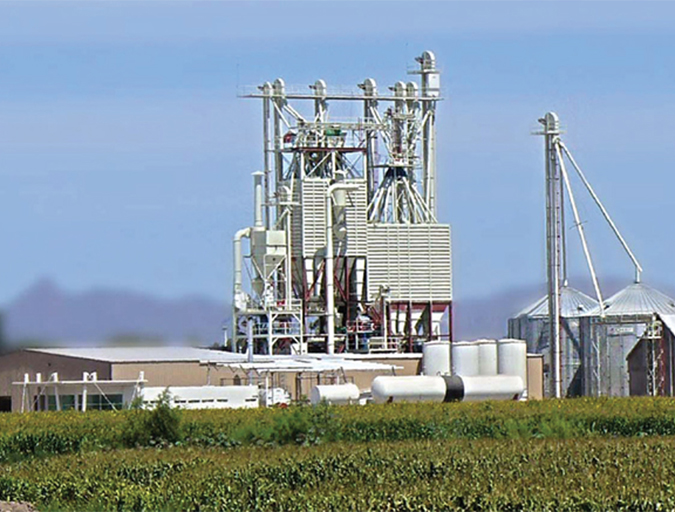
Aquafeeds
The Bottom Line: Integrating feed manufacturing into fish or shrimp production operations
Incorporating feed manufacturing into an aquaculture business offers greater and more efficient product access, control and logistics, as well as additional profit potential. A feasibility study that plans for growth and includes both a business plan and economic analysis is a must.
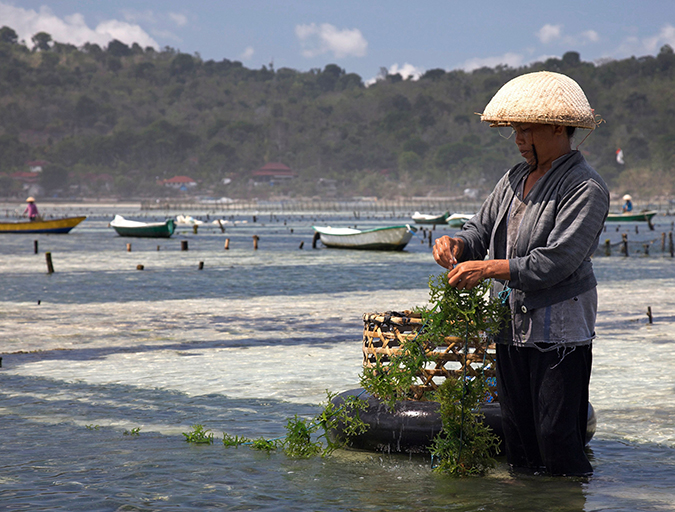
Responsibility
Can sustainable mariculture match agriculture’s output?
Global, sustainable mariculture production, developed on a massive, sustainable scale and using just a small fraction of the world’s oceanic areas, could eventually match the output of land-based agriculture production. Scale and international law considerations require the involvement of many stakeholders, including national governments and international organizations.
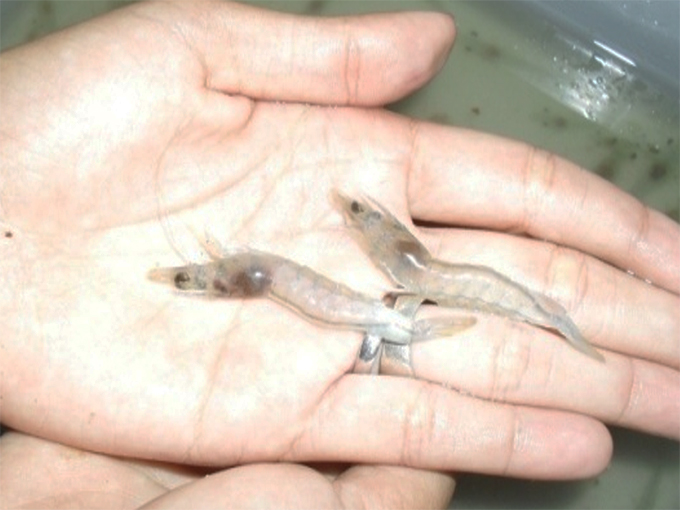
Aquafeeds
Rotifers and diatoms aid shrimp biofloc nurseries
Larval shrimp performance (feed conversion and final weight) in a biofloc nursery system improved with both added diatoms (Navicula sp.) and rotifers (Brachionus plicatilis).


